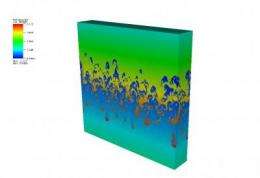Over two billion hours served: Using Argonne's supercomputer to drive discovery and innovation

The Argonne Leadership Computing Facility (ALCF), located at the Argonne National Laboratory, has run over two billion processor-hours of computations at a mind-boggling speed of over 557 trillion calculations a second as it enables scientists and engineers to conduct cutting-edge research in just weeks or months rather than years.
"The ALCF is dedicated to enabling breakthrough science - science that will change our world," said Pete Beckman, director of the ALCF. "From understanding the basic building blocks of nature to fueling industry and driving innovation, the power of supercomputers touches all of our lives."
No longer mere tools in the search for technical knowledge, supercomputers have become increasingly essential to almost every aspect of science and engineering. For example, researchers are using Argonne's supercomputer to:
- Model the molecular basis of Parkinson's disease to develop new treatments
- Assess the impacts of regional climate change
- Design technologies to reduce aerodynamic noise and cut carbon emissions
- Gain insight into dangerous heart rhythm disorders
- Design new materials required for lithium-air batteries
The ALCF is home to the IBM Blue Gene/P Intrepid, one of the fastest supercomputers in the world for open science. Intrepid features more than 160,000 processors and more than 80 terabytes of memory. Intrepid boasts a peak performance of 557 teraflops, but despite its power, the energy-efficient system uses about one-third as much electricity as a machine of comparable size built with more conventional parts.
ALCF is dedicated to large-scale computation and builds on Argonne's strengths in high-performance computing software, advanced hardware architectures and applications expertise. Argonne is also collaborating with several institutions on developing the next generation of hardware and software for supercomputers. Called "exascale computers," these machines will be so powerful that they can perform a quintillion, or a billion billion, calculations every second.
The ALCF is part of DOE's effort to provide leadership-class computing resources to the scientific community. DOE selects major ALCF projects through the Innovative and Novel Computational Impact on Theory and Experiment (INCITE) program. INCITE enables researchers to conduct simulations that would otherwise be out of reach on less powerful systems, because they would take years or decades to carry out.
Provided by Argonne National Laboratory


















